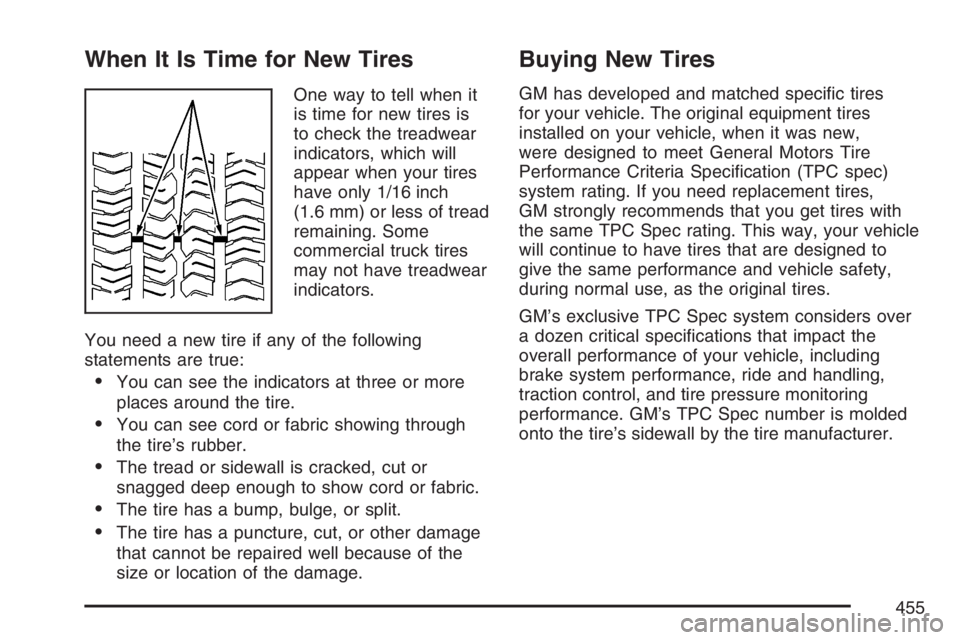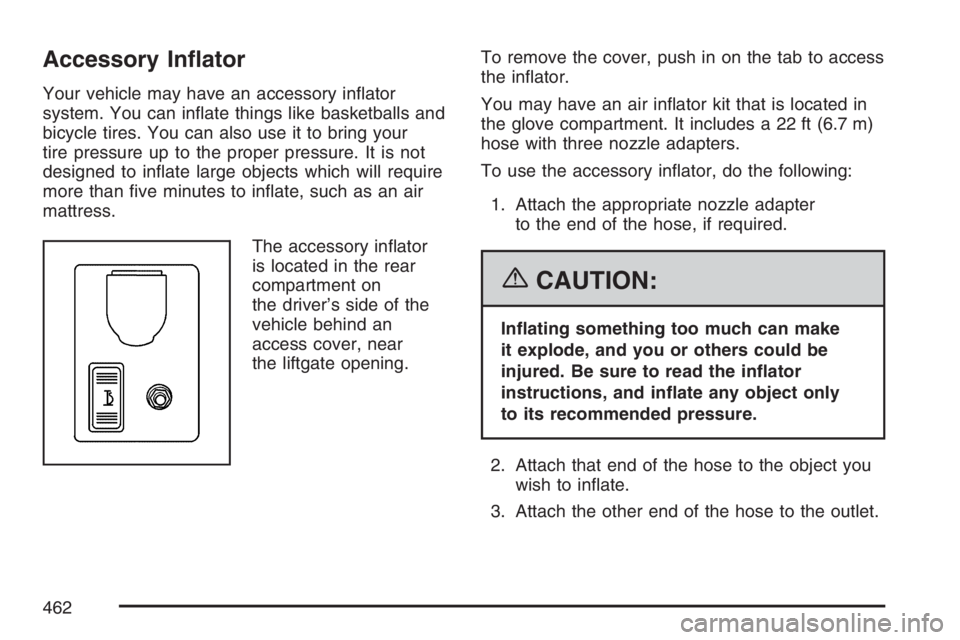Page 452 of 562

5. Remove the valve cap from the valve cap stem.
Activate the TPMS sensor by increasing or
decreasing the tire’s air pressure for
10 seconds, then stop and listen for a single
horn chirp. The single horn chirp should sound
within 15 seconds, con�rming that the sensor
identi�cation code has been matched to this
tire and wheel position. If you do not hear the
con�rming single horn chirp, you will need to
start over with step number one. To let
air-pressure out of a tire you can use the
pointed end of the valve cap, a pencil-style air
pressure gage, or a key.
6. Proceed to the passenger’s side front tire,
and repeat the procedure in Step 5.
7. Proceed to the passenger’s side rear tire,
and repeat the procedure in Step 5.
8. Proceed to the driver’s side rear tire, and
repeat the procedure in Step 5.9. After hearing the con�rming horn chirp for
the driver’s side rear tire, check to see if
the TPMS warning light is still �ashing. If yes,
turn the ignition switch to LOCK to exit the
sensor matching process. If the TPMS warning
light is not �ashing, the �ve minute time
limit has passed and you will need to start
the process over beginning with Step 1.
10. Set all four tires to the recommended air
pressure level as indicated on the Tire
and Loading Information label.
11. Put the valve caps back on the valve stems
The spare tire does not have a TPMS sensor.
If you replace one of the road tires with the spare,
the SERVICE TIRE MONITOR message will be
displayed on the DIC screen. This message should
go off once you re-install the road tire containing
the TPMS sensor.
452
Page 453 of 562

Federal Communications Commission
(FCC) and Industry and Science Canada
The Tire Pressure Monitor System (TPMS)
operates on a radio frequency and complies with
Part 15 of the FCC Rules. Operation is subject
to the following two conditions:
1. This device may not cause harmful
interference.
2. This device must accept any interference
received, including interference that may
cause undesired operation.
The Tire Pressure Monitor System (TPMS)
operates on a radio frequency and complies with
RSS-210 of Industry and Science Canada.
Operation is subject to the following two conditions:
1. This device may not cause interference.
2. This device must accept any interference
received, including interference that may
cause undesired operation of the device.
Changes or modi�cations to this system by other
than an authorized service facility could void
authorization to use this equipment.
Tire Inspection and Rotation
Tires should be rotated every 5,000 to 8,000 miles
(8 000 to 13 000 km).
Any time you notice unusual wear, rotate your
tires as soon as possible and check wheel
alignment. Also check for damaged tires or wheels.
SeeWhen It Is Time for New Tires on page 455
andWheel Replacement on page 460for
more information.
Make sure the spare tire is stored securely. Push,
pull, and then try to rotate or turn the tire. If it
moves, use the wheel wrench to tighten the cable.
For information on storing or removing the
spare tire, seeChanging a Flat Tire on page 465.
The purpose of regular rotation is to achieve
more uniform wear for all tires on the vehicle. The
�rst rotation is the most important. SeeScheduled
Maintenance on page 507.
453
Page 454 of 562

When rotating your tires, always use the correct
rotation pattern shown here.
After the tires have been rotated, adjust the front
and rear in�ation pressures as shown on the
Tire and Loading Information label. SeeLoading
Your Vehicle on page 349, for an example of
the label and its location on your vehicle.
The Tire Pressure Monitor System (TPMS)
sensors will need to be reset after a tire rotation.
See “TPMS Sensor Identi�cation Codes” under
Tire Pressure Monitor System on page 448.Make certain that all wheel nuts are properly
tightened. See “Wheel Nut Torque” under
Capacities and Speci�cations on page 502.
{CAUTION:
Rust or dirt on a wheel, or on the parts to
which it is fastened, can make wheel nuts
become loose after time. The wheel could
come off and cause an accident. When
you change a wheel, remove any rust or
dirt from places where the wheel attaches
to the vehicle. In an emergency, you can
use a cloth or a paper towel to do this;
but be sure to use a scraper or wire brush
later, if needed, to get all the rust or dirt
off. SeeChanging a Flat Tire on page 465.
454
Page 455 of 562

When It Is Time for New Tires
One way to tell when it
is time for new tires is
to check the treadwear
indicators, which will
appear when your tires
have only 1/16 inch
(1.6 mm) or less of tread
remaining. Some
commercial truck tires
may not have treadwear
indicators.
You need a new tire if any of the following
statements are true:
You can see the indicators at three or more
places around the tire.
You can see cord or fabric showing through
the tire’s rubber.
The tread or sidewall is cracked, cut or
snagged deep enough to show cord or fabric.
The tire has a bump, bulge, or split.
The tire has a puncture, cut, or other damage
that cannot be repaired well because of the
size or location of the damage.
Buying New Tires
GM has developed and matched speci�c tires
for your vehicle. The original equipment tires
installed on your vehicle, when it was new,
were designed to meet General Motors Tire
Performance Criteria Speci�cation (TPC spec)
system rating. If you need replacement tires,
GM strongly recommends that you get tires with
the same TPC Spec rating. This way, your vehicle
will continue to have tires that are designed to
give the same performance and vehicle safety,
during normal use, as the original tires.
GM’s exclusive TPC Spec system considers over
a dozen critical speci�cations that impact the
overall performance of your vehicle, including
brake system performance, ride and handling,
traction control, and tire pressure monitoring
performance. GM’s TPC Spec number is molded
onto the tire’s sidewall by the tire manufacturer.
455
Page 456 of 562

If the tires have an all-season tread design, the
TPC spec number will be followed by a MS,
for mud and snow. SeeTire Sidewall Labeling
on page 440for additional information.
{CAUTION:
Mixing tires could cause you to lose
control while driving. If you mix tires of
different sizes, brands, or types (radial
and bias-belted tires) the vehicle may not
handle properly, and you could have a
crash. Using tires of different sizes,
brands, or types may also cause damage
to your vehicle. Be sure to use the correct
size, brand, and type of tires on your
vehicle’s wheels.
{CAUTION:
If you use bias-ply tires on your vehicle,
the wheel rim �anges could develop
cracks after many miles of driving. A tire
and/or wheel could fail suddenly, causing
a crash. Use only radial-ply tires with the
wheels on your vehicle.
If you must replace your vehicle’s tires with those
that do not have a TPC Spec number, make
sure they are the same size, load range, speed
rating, and construction type (radial and
bias-belted tires) as your vehicle’s original tires.
Vehicles equipped with a tire pressure monitoring
system may give an inaccurate low-pressure
warning if non-TPC spec rated tires are installed
on your vehicle. Non-TPC Spec rated tires
may give a low-pressure warning that is higher or
lower than the proper warning level you would
get with TPC Spec rated tires. SeeTire Pressure
Monitor System on page 448.
456
Page 462 of 562

Accessory In�ator
Your vehicle may have an accessory in�ator
system. You can in�ate things like basketballs and
bicycle tires. You can also use it to bring your
tire pressure up to the proper pressure. It is not
designed to in�ate large objects which will require
more than �ve minutes to in�ate, such as an air
mattress.
The accessory in�ator
is located in the rear
compartment on
the driver’s side of the
vehicle behind an
access cover, near
the liftgate opening.To remove the cover, push in on the tab to access
the in�ator.
You may have an air in�ator kit that is located in
the glove compartment. It includes a 22 ft (6.7 m)
hose with three nozzle adapters.
To use the accessory in�ator, do the following:
1. Attach the appropriate nozzle adapter
to the end of the hose, if required.
{CAUTION:
In�ating something too much can make
it explode, and you or others could be
injured. Be sure to read the in�ator
instructions, and in�ate any object only
to its recommended pressure.
2. Attach that end of the hose to the object you
wish to in�ate.
3. Attach the other end of the hose to the outlet.
462
Page 481 of 562

A. Handle
B. Wheel Wrench
C. Instruction LabelD. Extension(s)
E. Knob
F. Wheel Blocks and Jack
1. Attach the handle (A), wheel wrench (B),
and extension (D) in the slots provided.
2. Roll up the instruction label (C) and return
to the slot in the tool kit.
3. Assemble the wheel blocks (F) to the jack.
4. Turn the knob (E) on the jack clockwise to
raise the jack head.
5. Return the rear seat to its proper position.
Spare Tire
Your vehicle, when new, had a fully-in�ated spare
tire. A spare tire may lose air over time, so check its
in�ation pressure regularly. SeeIn�ation - Tire
Pressure on page 447andLoading Your Vehicle
on page 349for information regarding proper tire
in�ation and loading your vehicle. For instruction on
how to remove, install or store a spare tire, see
Removing the Flat Tire and Installing the Spare Tire
on page 469andStoring a Flat or Spare Tire and
Tools on page 478.
After installing the spare tire on your vehicle, you
should stop as soon as possible and make
sure the spare is correctly in�ated. Have the
damaged or �at road tire repaired or replaced as
soon as you can and installed back onto your
vehicle. This way, a spare tire will be available
in case you need it again.
Do not mix tires and wheels of different sizes,
because they will not �t. Keep your spare tire
and its wheel together.
481
Page 509 of 562

Scheduled Maintenance
Service MaintenanceIMaintenanceII
Change engine oil and �lter. SeeEngine Oil on page 394. Reset oil life system.
SeeEngine Oil Life System on page 398.An Emission Control Service.••
Visually check for any leaks or damage.See footnote (j).••
Inspect engine air cleaner �lter. If necessary, replace �lter. SeeEngine Air
Cleaner/Filter on page 400.See footnote (k).•
Rotate tires and check in�ation pressures and wear. SeeTire Inspection and
Rotation on page 453and “Tire Wear Inspection” inAt Least Once a Month
on page 514.••
Inspect brake system.See footnote (a).••
Check engine coolant and windshield washer �uid levels and add �uid as
needed.••
Perform any needed additional services. See “Additional Required Services”
in this section.••
Inspect suspension and steering components.See footnote (b).•
Inspect engine cooling system.See footnote (c).•
Inspect wiper blades.See footnote (d).•
Inspect restraint system components.See footnote (e).•
Lubricate body components.See footnote (f).•
Check transmission �uid level and add �uid as needed.See footnote (g).•
509